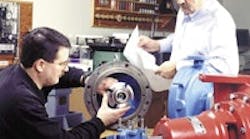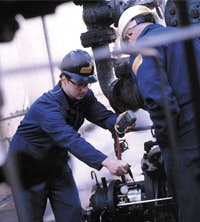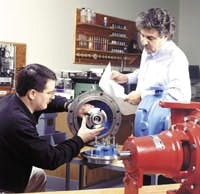When it comes to pumps and seals, eventually they need to be repaired or replaced. It would seem that implementing a good predictive maintenance program would make these changeovers seamless and less disruptive. However, predicting precise pump or seal failure is a difficult exercise at best.
For this reason, chemical plants and refineries generally will not remove seals and pumps from service until they experience problems. The logic is that if they are going to fail anyway, you might as well get the most out of them before repair or replacement becomes necessary. How then do you avoid calling your repair staff to action at the most inopportune times?
One way to improve productivity is to maximize the elapsed time between seal installation and replacement. The goal is to make sure that the seal dies of old age rather than from some other factor. You want to halt premature wear and rely on the service life the seal or pump manufacturer provided.
Knowing that a specific seal is designed to last for a given number of years is a good predictability measure. It’s the premature failure that tends to disrupt production and cost more in repairs. The issue is really about reliability. A maintenance staff can increase uptime by developing an effective seal reliability program.
To make it official, assign the program to your reliability engineer (or to someone responsible for the equipment, such as your rotating equipment engineer). Make sure this person has the ability to facilitate change should it become necessary.
Here are five basic steps for instituting an effective seal reliability program.
Step 1: Collect data
An effective reliability program requires keeping good records. This will allow you to establish a baseline that can be used to assess progress. Input data for every pump with a seal into a database that’s been established specifically for the reliability program.
The database should contain key information, such as the pump type and seal types as well as several critical operating conditions, including the suction, discharge and stuffing box pressures; the operating temperature; the specific gravity or density of the process liquid; and the vapor pressure and viscosity at operating temperature.
[pullquote]When a pump failure occurs, enter the date it happened along with any pertinent information about the root cause (more on this later). Some plants record every outage, regardless of the cause. This method would include non-repair factors, such as equipment upgrades. Overall, it doesn’t matter how you do it, as long as you are consistent and can make valid comparisons. You want to determine how many pumps were repaired each month in relation to the total pump population.
With this data, the mean-time-between- repairs (MTBR) can be determined. This statistical measurement can be used to graph and identify trends. Determining MTBR is simple: Divide the total pump population by the number of repairs each month. For example, if there are 100 pumps and 10 repairs in a month, the MTBR is 10 months. If your monthly repairs are five, the MTBR would be 20 months.
For a more complete record, indicate which were seal failures. (For example, if a bearing failure caused the seal leak, this should not be considered a seal failure.) Track the mean time between seal failure (MTBSF). This is a subset of MTBR.
Using the example from above, two seal failures were detected. Therefore, MTBSF is 50 months (100 pumps divided by two seal failures). This will provide a good idea on where to focus repair and maintenance efforts.
Step 2: Identify bad actors
Most plants are too busy to perform root cause analyses on every failure. However, your recordkeeping will assist in determining where to invest repair time. Naturally, focus on the bad actors — the pumps and seals that consistently fail prematurely. For example, if the plant has 10 pumps, and the MTBSF is five years for five of them and one year for the others, you know which pumps to focus on. Improving the plantwide MBTSF average will reduce maintenance costs and increase uptime and productivity.
The next three steps focus on improving both MTBR and MTBSF.
Step 3: Understand the pumping system
This can sometimes be the most difficult part, but it’s also the most important. The objective is to understand both how the system should work and how it is working. You need the ability to compare the two and identify shortcomings.
The information analyzed should go beyond the initial operating data. It should include factors specific to a single pump. For example, does the service have fluctuating flows? How stable is the flow and is it controlled? The more stable it is, the more likely the pump will run for a long time. Instability, meanwhile, may lead to premature seal failure.
For example, a refinery had a large pipe that ran from the pump to the dock facility a mile-and-a-half away. The dock personnel would fill a tanker and close the valve when finished. However, the pump was still operating. This created a pressure wave that shot back through the pipe into the pumping system. The catastrophic results included burst pipes, a failed bearing housing and seal, and damage to the pump. In fact, the power of the pressure wave shook the pump from its foundation.
Although an extreme example, this underscores a critical need to examine each part of a system and determine what environmental factors could contribute to failures. In this case, the answer was to install a remote pump which could be shut off at the docks. Understanding these factors beforehand could have prevented the expensive repairs, not to mention the productivity loss and safety concerns.
Step 4: Analyze the failures
Analysis begins when you remove the failed components and study them. Look for signs of wear. For example, several hard wear spots on the mating ring may indicate that the gland was pulled too tightly. Or, if the O-rings are damaged, and you have ruled out mechanical or chemical problems, you may have a thermal problem. If the pump does not normally run hot, you may discover the seal wasn’t getting a proper flush. Therefore, the problem may be a crimped flush line.
More often than not, a seal failure is due to a system-wide problem. In other words, outside factors contribute to premature wear and failure. Some of the most common causes include: installation errors, equipment problems and incorrectly specified seals.
Installation errors. An operator may inadvertently contaminate a seal with the grit or dirt on his hands. Even a small dirt particle between the seal faces can contribute to wear. The operator may have left out the gaskets or installed the seal incorrectly. If the seal faces are not square, they will wobble during operation, causing wear and leakage.
Equipment problems. One example is pipe strain. A bad pipe fit to the pump’s discharge connection can pull on the casing, creating distortion. Ultimately, this pulls the stuffing box out of alignment, causing premature seal wear. Pipe strain is just one of many causes of misalignment — most of which will lead to seal failure.
Specifying the wrong seal. To select the right seal for the application, every factor must be considered. If something is left out, the seal may be inadequate for its operating conditions. A recent case illustrates this point. After providing the pertinent operating conditions, one refinery indicated that hydrocarbon would be the process fluid. A seal was selected and put into service. It failed after a short period of time. As it turned out, the fluid was not hydrocarbon. This one piece of missing information resulted in the wrong seal being specified.
Step 5: Take action
Once the root cause of failure is identified, the appropriate action may become apparent. In the case of the pressurized pipe line, the answer was to stop the pump remotely. To fix installation errors, a plant needs to improve training of key personnel. Problems can be remedied by adjusting equipment, installing new support systems or selecting seals designed to operate in harsher conditions.
Now that the solution is identified, how does the reliability engineer obtain the authorization and the right personnel to make the corrections? With processes, such as “Management of Change,” that dictate how projects will be accomplished, the reliability engineer may have to obtain agreement from many people within the plant, including the foreman, maintenance engineer and management.
If you set up your seal reliability program properly, getting buy-in from key people should not be difficult. Your carefully prepared records can go a long way in demonstrating that action is necessary. As you increase the use of MTBR and MTBSF, the momentum for continuous improvement will be difficult to stop.


